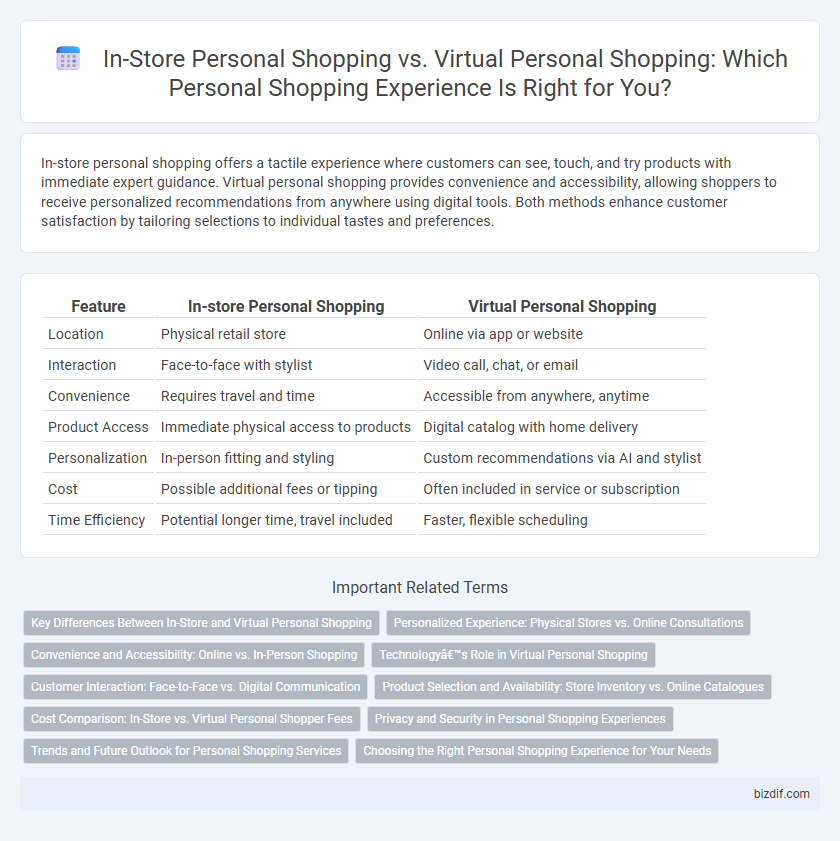In-store personal shopping offers a tactile experience where customers can see, touch, and try products with immediate expert guidance. Virtual personal shopping provides convenience and accessibility, allowing shoppers to receive personalized recommendations from anywhere using digital tools. Both methods enhance customer satisfaction by tailoring selections to individual tastes and preferences.
Table of Comparison
| Feature | In-store Personal Shopping | Virtual Personal Shopping |
|---|---|---|
| Location | Physical retail store | Online via app or website |
| Interaction | Face-to-face with stylist | Video call, chat, or email |
| Convenience | Requires travel and time | Accessible from anywhere, anytime |
| Product Access | Immediate physical access to products | Digital catalog with home delivery |
| Personalization | In-person fitting and styling | Custom recommendations via AI and stylist |
| Cost | Possible additional fees or tipping | Often included in service or subscription |
| Time Efficiency | Potential longer time, travel included | Faster, flexible scheduling |
Key Differences Between In-Store and Virtual Personal Shopping
In-store personal shopping offers tactile experiences with immediate product access, allowing clients to try items and utilize face-to-face stylist expertise. Virtual personal shopping provides convenience and accessibility through digital platforms, enabling personalized recommendations and purchases from home without geographical limitations. Key differences include sensory engagement, immediacy of product availability, and the mode of communication between shopper and consultant.
Personalized Experience: Physical Stores vs. Online Consultations
In-store personal shopping offers a tactile and immersive personalized experience, allowing customers to physically interact with products and receive immediate, face-to-face styling advice from experienced consultants. Virtual personal shopping leverages advanced online consultations and AI-driven recommendations to tailor selections based on detailed customer profiles and preferences, providing convenience without geographic limitations. Both methods prioritize personalized shopping, but physical stores excel in sensory engagement while virtual services emphasize accessibility and data-driven customization.
Convenience and Accessibility: Online vs. In-Person Shopping
In-store personal shopping offers immediate product access and face-to-face assistance within a physical retail environment, enhancing tactile evaluation and instant gratification. Virtual personal shopping provides convenience through 24/7 availability, broad product selections, and eliminates geographic constraints by enabling remote consultations and online ordering. Accessibility is expanded online by integrating digital tools such as live chats, virtual try-ons, and personalized recommendations, catering to diverse customer preferences and schedules.
Technology’s Role in Virtual Personal Shopping
Virtual personal shopping leverages advanced AI algorithms and augmented reality to provide personalized style recommendations and simulate try-on experiences, enhancing customer convenience and engagement. Real-time chatbots and video consultations facilitate instant interaction with professional shoppers, replicating the personalized assistance found in-store. The integration of data analytics allows virtual platforms to tailor suggestions based on individual preferences and purchase history, optimizing the shopping experience beyond traditional in-store visits.
Customer Interaction: Face-to-Face vs. Digital Communication
In-store personal shopping offers direct, face-to-face interaction, allowing customers to receive immediate, personalized assistance and try products firsthand. Virtual personal shopping relies on digital communication tools such as video calls and chats, providing convenience and access to expert advice without geographical limitations. Both methods emphasize tailored experiences, but in-store interactions foster tactile engagement while virtual services enhance accessibility and flexibility.
Product Selection and Availability: Store Inventory vs. Online Catalogues
In-store personal shopping allows customers to physically browse store inventory, ensuring immediate access to available products and the ability to inspect quality firsthand. Virtual personal shopping relies on extensive online catalogues, offering a broader range of products but sometimes facing delays due to shipping or stock updates. Comparing both, in-store shopping excels in real-time product availability, while virtual platforms provide convenience and a wider selection through digital access.
Cost Comparison: In-Store vs. Virtual Personal Shopper Fees
In-store personal shopping typically involves higher fees due to overhead costs like store space and staff salaries, with prices averaging $50 to $150 per hour. Virtual personal shopping services often offer more affordable rates, ranging from $30 to $100 per hour, benefiting from lower operational expenses and broader access to online retailers. Both options may include product markups or service fees, but virtual shopping provides cost-effective flexibility without compromising personalized style recommendations.
Privacy and Security in Personal Shopping Experiences
In-store personal shopping offers enhanced privacy through direct control over physical interactions and secure payment methods, minimizing digital data exposure. Virtual personal shopping relies on encrypted platforms and strict data protection protocols to safeguard sensitive information during online consultations and transactions. Both formats prioritize confidentiality, yet virtual experiences demand robust cybersecurity measures to address potential risks inherent in digital communications and data storage.
Trends and Future Outlook for Personal Shopping Services
In-store personal shopping continues to leverage immersive, tactile experiences essential for discerning customers, while virtual personal shopping gains momentum through AI-driven recommendations and real-time video consultations. Market trends indicate a hybrid model blending physical and digital touchpoints, enhancing convenience and personalization. Future outlooks project increased adoption of augmented reality, machine learning, and data analytics to create seamless, customized shopping journeys across both channels.
Choosing the Right Personal Shopping Experience for Your Needs
In-store personal shopping offers immediate, tactile experiences and personalized styling with direct access to products, ideal for those who prefer hands-on selection and instant gratification. Virtual personal shopping provides convenience and flexibility, leveraging digital tools and curated recommendations tailored to individual preferences, perfect for busy schedules or remote clients. Assess your lifestyle, shopping goals, and desired level of interaction to choose the most effective personal shopping experience for your needs.
In-store personal shopping vs Virtual personal shopping Infographic

 bizdif.com
bizdif.com